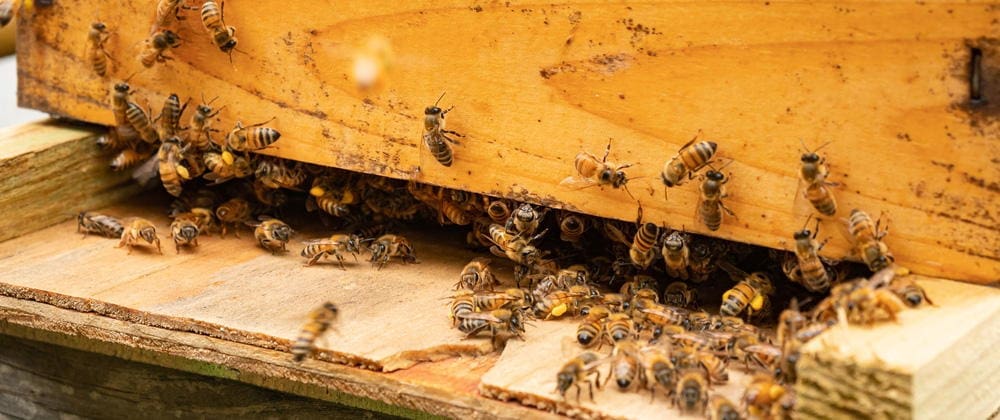Maybe you’ve decided to keep bees and like most new beekeepers, you are full of anticipation for your new adventure.
Perhaps your native bee population is dwindling, and you’re in need of pollination help, or maybe it has been your lifelong dream to keep bees. Either way being a backyard beekeeper is very rewarding.
You will not only be benefiting yourself but also:
- Your garden: By introducing pollinators, your garden should increase production, giving you more food.
- The bees: By keeping a backyard hive, you are helping a species that has been declining.
- Education: The experience and education you gain by keeping bees will teach you new skills and instill a love of learning that you can share with family and friends.
Before you jump in and turn your backyard into a honeybee haven, you must make a few decisions. Let’s go over them.
Hive Type
Whether you buy an already assembled hive, a beehive starter kit, or you DIY a hive; you should know the pros and cons of each.
Langstroth Hive
The Langstroth hive is a vertical frame hive and is by far the most popular style of hive. For this reason, it is the hive type most commonly chosen by beginner beekeepers.
Frames and equipment to manage Langstroth hives are readily available, and the majority of information online relates to the care and keeping of Langstroth hives. The downside of the Langstroth hive is that it is a series of boxes that are stacked upon one another. To thoroughly inspect the hive involves lifting each box off of the stack. Depending on the size of the boxes you choose, that could be anywhere from 60-100 pounds.
Hive inspections are also intrusive; you must remove each box, fully exposing each hive body. You are literally removing the roof of their home to take a peek. Stressful!
Related: Most Threatening Insects You Should Keep Away From Your Garden

Top Bar Hive
The Top Bar Hive (TBH) is the oldest hive style, dating back to 1600’s Greece.
It is a frameless horizontal hive that lays single bars across the top of the hive cavity to form the ceiling of the hive, hence the name, top bars. TBH’s do not require heavy lifting. Each bar is removed one at a time for inspection. At most, a bar full of honey would weigh anywhere from 4-8 pounds—a much better choice for seniors or those with injuries that prohibit heavy lifting.
Inspections are less invasive; removing only one bar at a time exposes only a tiny section of bees, creating a calmer inspection process for the bees and you.
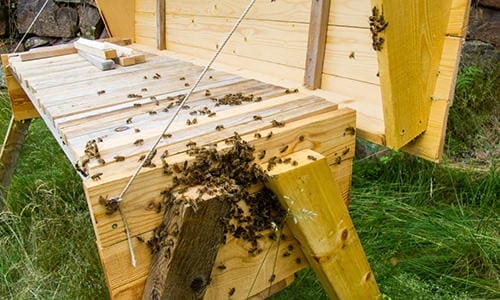
Flow Hive
A recent arrival on the beekeeping scene, the Australian-born Flow Hive was just introduced in 2015. Its appearance sparked controversy as it became a fan favorite among new beekeepers.
The tappable Flow Hives patented system uses plastic frames, much like a Langstroth hive, but the frames have larger pre-formed cells for the bees to fill with honey. The honey may be extracted by turning a key, which allows the frame to open and the honey to flow through the tap and into your honey jar.
The advantage of this is the ease of use; the hive is not opened, and the bees are not bothered. However, this may encourage beekeepers to ignore routine hive inspections, putting their colony at risk. Another drawback could be that bees do not always take to plastic comb, which may be easily fixed by painting the comb with a light layer of wax.
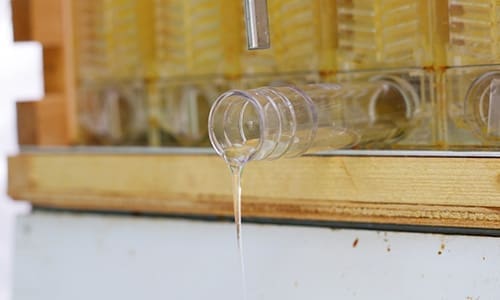
Location
You have chosen the style of hive you will use. Now, you need to set it up.
Here are a few things you should consider when putting your hive in your backyard, not only for the health of your bees but also for your safety when working your hives.
- The entrance should be facing the Southeast.
- If possible, place hive near a natural windbreak.
- Make sure the area receives a mixture of sun and shade. In northern climates, ensure the site receives ample sunlight in the winter months.
- The location should be well ventilated, not windy, but not in a low spot with still air.
- Make sure the ground is dry and firm.
- Make sure there is a food and water source nearby.
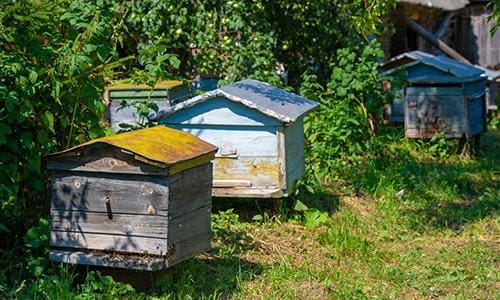
Getting Your Bees
Now that you have chosen your hive and location, it is time to get some bees. Depending on your chosen hive, there are different options for obtaining your new bees. No matter which option you choose, it is an exciting time. You are about to become a beekeeper.
Packages
You can purchase packages of bees anywhere from large beekeeping supply stores to local apiaries. Packages typically come with 3 pounds of bees (around 10,000 bees). The bees are housed inside a screened wooden “package” along with a supply of sugar syrup and a mated queen. Packages are a relatively inexpensive and simple way for beginners to obtain bees.
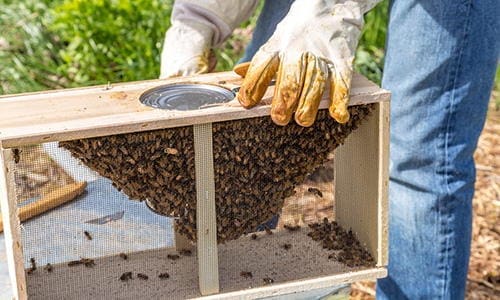
Nucs
With a Langstroth or Flow hive, you can buy your new bees in a nucleus colony (nuc). A nuc is a small colony of 10,000-15,000 bees and a mated queen. The benefit of a nuc is that it consists of 3-5 frames that have already been drawn out with brood and honey. Though usually more expensive than a package, a nuc is a great benefit to a beginning beekeeper as the colony already has a head start.

Swarm
If you are feeling adventurous or perhaps on a tight budget, you can take your chances by attempting to catch a wild swarm. This is not the easiest method for beginners, but it is worth mentioning as a possibility.
In the spring and early summer, bees have a natural tendency to swarm, their hives may have reached a bursting point, and it is time for that colony to reproduce by splitting in half. Bees in a swarm are local to the environment where they are found, meaning they have overwintered successfully.
Related: Trees In Your Backyard You Should Tap Right Now
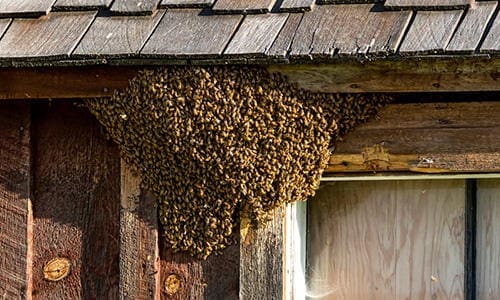
Feeding
No matter how your new bees come to you, they will need to be fed.
You will be receiving your new bees in the spring; this gives them time to get comb established, increase their numbers and store honey for the winter, increasing their chance of survival. It takes 6-8 pounds of honey or sugar syrup to produce 1 pound of wax. It is suggested in the spring to feed a 1:1 ratio of sugar syrup (1 part water to 1 part sugar).
Feeding your bees until they have at least 6-8 drawn-out frames is recommended; you may choose to stop at that point.
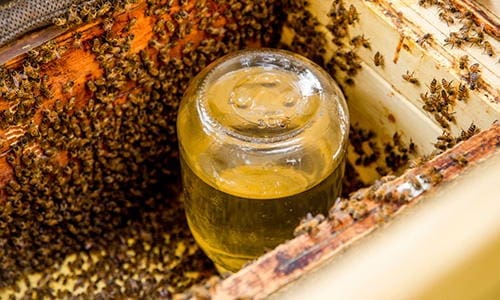
Care And Health
You will not need to care for your bees daily, but they will need routine inspections to ensure their well-being.
Regular inspections allow you to check for any disease or pests that may be present in your hive. Conditions such as American foulbrood (AFB) and European foulbrood (EFB) can weaken colonies and lead to their death. Parasites such as Varroa mites need to be monitored for and treated accordingly. It is essential that you check on your hives regularly to notice any irregularities. Most diseases are treatable if caught in time.
Beekeeping can come with a steep learning curve; reaching out to an established beekeeper in your area or joining a group (either in person or online) is always recommended for mentorship. But if that isn’t possible, read.
Read websites, books, whatever you can get your hands on. And spend time with your bees and observe them; this time spent in your backyard getting to know your bees will build your confidence and your knowledge.
You may also like:
 What To Do If You See A Bat On Your Homestead
What To Do If You See A Bat On Your Homestead
An Insanely Effective Way to Build a 5 Year Food Stockpile (Video)
5 Mistakes To Avoid On Your Property
DIY Dutch Bucket Hydroponics System
How To Attract Toads and Frogs to Your Garden (And Why You Should Do It)
